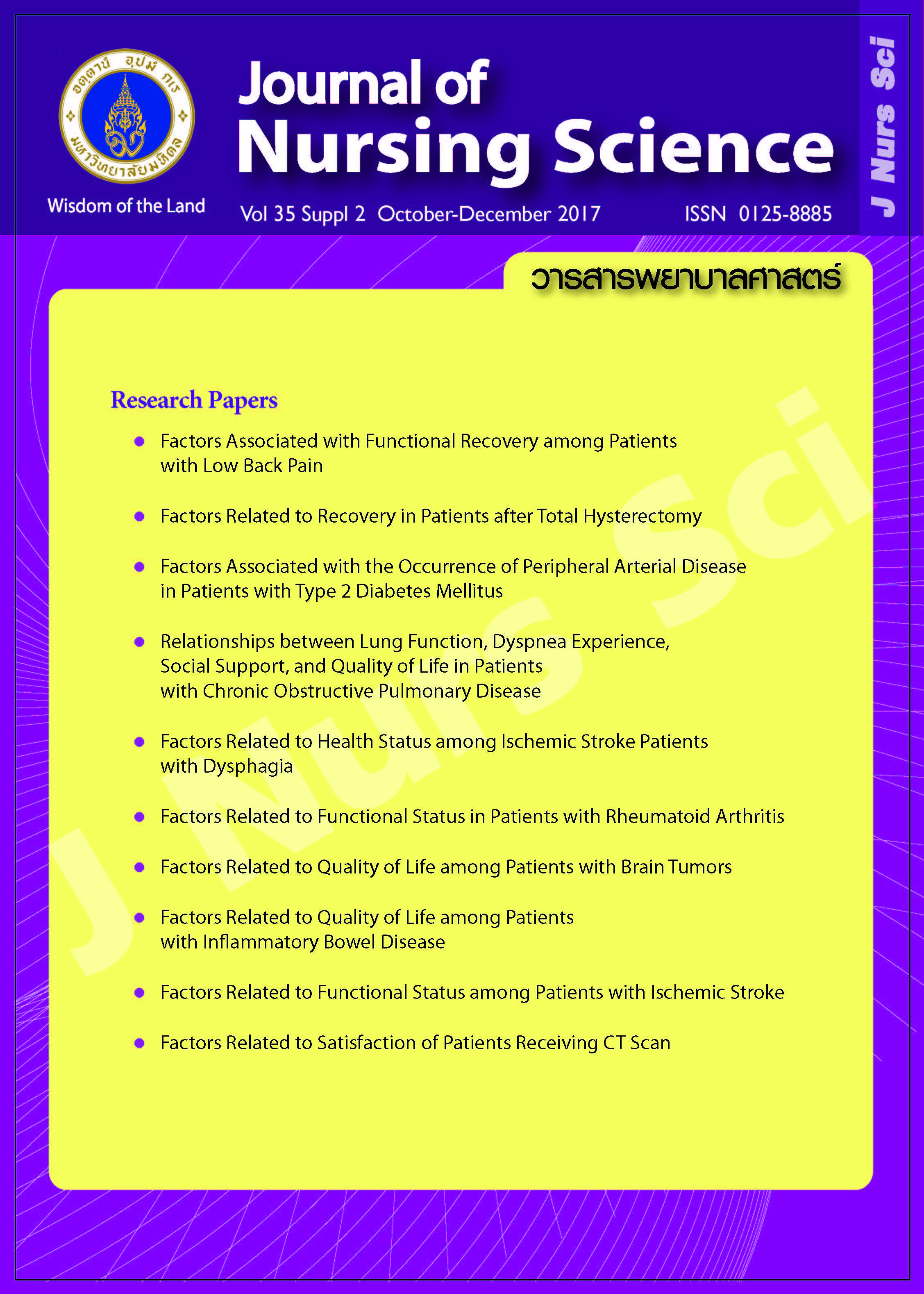Factors Associated with Functional Recovery among Patients with Low Back Pain ปัจจัยที่มีความสัมพันธ์กับการฟื้นตัวด้านการทำหน้าที่ในผู้ป่วยที่มีอาการปวดหลังส่วนล่าง
Main Article Content
Abstract
Abstract
Purpose: To examine the relationships between pain, pain self-efficacy, anxiety, depression, and co-morbid diseases with functional recovery among patients with low back pain (LBP).
Design: Descriptive correlational design.
Methods: The sample was 126 patients with LBP who were treated in Rheumatology Unit at Bach Mai Hospital, Hanoi, Vietnam. Data were collected using patients’ hospital record and 4 questionnaires: 1) the Numerical Rating Scale, 2) the Pain Self-efficacy Questionnaire, 3) the Hamilton Anxiety Rating Scale and Hamilton Depression Rating Scale, 4) the Oswestry Disability Index. Spearman’s Rho was employed to test the relationships among studied variables.
Main findings: The findings revealed that pain was negatively correlated with functional recovery (rs = - .56, p < .05), anxiety and depression were also negatively correlated with functional recovery (rs = - .46, - .58, p < .05). Pain self-efficacy was positively correlated with functional recovery (rs = .48, p < .05). Nevertheless, co-morbidity did not correlate with functional recovery (p > .05).
Conclusion and recommendation: To improve patients’ functional recovery, nurses should assess and control pain, anxiety and depression as well as increase pain self-efficacy. A comprehensive guideline to improve patients’ recovery should be developed and tested for its effectiveness with research before implementation.
บทคัดย่อ
วัตถุประสงค์: เพื่อศึกษาความสัมพันธ์ระหว่างความปวด การรับรู้สมรรถนะแห่งตนในการจัดการความเจ็บปวด ความวิตกกังวลและภาวะซึมเศร้า และโรคร่วมกับการฟื้นตัวด้านการทำหน้าที่ของผู้ป่วยที่มีอาการปวดหลังส่วนล่าง
รูปแบบการวิจัย: การวิจัยเชิงสหสัมพันธ์
วิธีดำเนินการวิจัย: ศึกษาในผู้ป่วยผู้ใหญ่จำนวน 126 คน ที่มารับการรักษาตัวแบบผู้ป่วยในด้วยอาการปวดหลัง ในหน่วยรูมาตอยด์ของโรงพยาบาลบัคมาย กรุงฮานอย ประเทศเวียดนาม เก็บข้อมูลบางส่วนจากแฟ้มประวัติผู้ป่วย และแบบสอบถามจำนวน 4 ชุด: 1) the Numerical Rating Scale, 2) the Pain Self-efficacy Questionnaire, 3) the Hamilton Anxiety Rating Scale and Hamilton Depression Rating Scale, 4) the Oswestry Disability Index ใช้สถิติ สเปียร์แมนโรว์ เพื่อวิเคราะห์ความสัมพันธ์ระหว่างตัวแปร
ผลการวิจัย: ผลการศึกษาพบว่า ความปวดมีความสัมพันธ์ทางลบกับการฟื้นตัวด้านการทำหน้าที่ของผู้ป่วยที่มีอาการปวดหลังส่วนล่าง (rs = - .56, p < .05) ความวิตกกังวลและภาวะซึมเศร้ามีความสัมพันธ์ทางลบกับการฟื้นตัว (rs = - .46, - .58, p < .05) การรับรู้สมรรถนะแห่งตนในการจัดการความเจ็บปวดมีความสัมพันธ์ทางบวกกับการฟื้นตัว (rs = .48, p < .05) ทั้งนี้ภาวะโรคร่วมมีความสัมพันธ์กับการฟื้นตัวอย่างไม่มีนัยสำคัญทางสถิติ (p > .05)
สรุปและข้อเสนอแนะ: เพื่อช่วยส่งเสริมการฟื้นตัวของผู้ป่วย พยาบาลควรประเมินและควบคุมอาการเจ็บปวด จัดการกับปัญหาความวิตกกังวล ภาวะซึมเศร้า และส่งเสริมให้ผู้ป่วยมีการรับรู้สมรรถนะแห่งตนในการจัดการความปวดด้วยตนเองเพิ่มขึ้น ควรมีการพัฒนาแนวปฏิบัติเพื่อการส่งเสริมการฟื้นตัวด้านการทำหน้าที่ของผู้ป่วยที่มีอาการปวดหลังส่วนล่าง และทดสอบประสิทธิผลของแนวปฏิบัติด้วยงานวิจัยก่อนนำไปใช้จริง
Article Details
Copyright Notice: Nursing Science Journal of Thailand has exclusive rights to publish and distribute the manuscript and all contents therein. Without the journal’s permission, the dissemination of the manuscript in another journal or online, and the reproduction of the manuscript for non-educational purpose are prohibited.

Disclaimer: The opinion expressed and figures provided in this journal, NSJT, are the sole responsibility of the authors. The editorial board bears no responsibility in this regard.
References
2. Cho NH, Jung YO, Lim SH, Chung C, Kim HA. The prevalence and risk factors of low back pain in rural community residents of Korea. Spine (Phila Pa 1976). 2012;37(24):2001-10.
3. Bean DJ, Johnson MH, Kydd RR. Relationships between psychological factors, pain, and disability in complex regional pain syndrome and low back pain. Clin J Pain. 2014;30(8):647-53.
4. Caby I, Olivier N, Mendelek F, Bou Kheir R, Vanvelcenaher J, Pelayo P. Functional restoration of the spine: effect of initial pain level on the performance of subjects with chronic low back pain. Pain Res Manag. 2014;19(5):e133-8.
5. Lambeek LC, van Tulder MW, Swinkels IC, Koppes LL, Anema JR, van Mechelen W. The trend in total cost of back pain in The Netherlands in the period 2002 to 2007. Spine (Phila Pa 1976). 2011;36(13):1050-8.
6. Gore M, Sadosky A, Stacey BR, Tai KS, Leslie D. The burden of chronic low back pain: clinical comorbidities, treatment patterns, and health care costs in usual care settings. Spine (Phila Pa 1976). 2012;37(11):E668-77.
7. Ferreira-Valente MA, Pais-Ribeiro JL, Jensen MP. Associations between psychosocial factors and pain intensity, physical functioning, and psychological functioning in patients with chronic pain. a cross-cultural comparison. Clin J Pain. 2014;30(8):713-23.
8. Thuy NTT. Prevalence of low back pain in population in Ho Chi Minh City: report of 8 district hospitals. Ho Chi Minh, Vietnam: Better Work; 2013.
9. Faul F, Erdfelder E, Buchner A, Lang AG. Statistical power analyses using G*Power 3.1: tests for correlation and regression analyses. Behav Res Methods. 2009;41(4):1149-60.
10. Cohen J. A power primer. Psychol Bull. 1992;112(1):155-9.
11. Bijur PE, Latimer CT, Gallagher EJ. Validation of a verbally administered numerical rating scale of acute pain for use in the emergency department. Acad Emerg Med. 2003;10(4):390-2.
12. Nicholas MK. The pain pain self-efficacy questionnaire: taking pain into account. Eur J Pain. 2007;11(2):153-63.
13. Hamilton M. A rating scale for depression. J Neurol Neurosurg Psychiatry. 1960 Feb;23:56-62. PubMed PMID: 14399272. PubMed Central PMCID: PMC495331.
14. Fairbank JC, Couper J, Davies JB, O’Brien JP. The Oswestry low back pain disability questionnaire. Physiotherapy. 1980;66(8):271-3.
15. Bailly F, Foltz V, Rozenberg S, Fautrel B, Gossec L. The impact of chronic low back pain is partly related to loss of social role: a qualitative study. Joint Bone Spine. 2015;82(6):437-41.
16. Friedman BW, Gensler S, Yoon A, Nerenberg R, Holden L, Bijur PE, et al. Predict three-month functional outcomes after an ED visit for acute low back pain. Am J Emerg Med. 2017;35(2):299-305.
17. Burgos-Vargas R, Braun J. Inflammatory back pain. Rheum Dis Clin North Am. 2012;38(3):487-99.
18. Pinheiro MB, Ferreira ML, Refshauge K, Maher CG, Ordoana JR, Andrade TB, et al. Symptoms of depression as a prognostic factor for low back pain: a systematic review. Spine J. 2016;16(1):105-16.
19. McIntosh G, Hall H, Boyle C. Outcomes for those with or without physical comorbidity for a specific cohort of chronic low back pain patients in an active rehabilitation approach. Adv Physiother. 2011;13:56–62. .
20. Beeckmans N, Vermeersch A, Lysens R, Van Wambeke P, Goossens N, Thys T, et al. The presence of respiratory disorders in individuals with low back pain: A systematic review. Man Ther. 2016 Dec;26:77-86. doi: 10.1016/j.math.2016.07.011.

